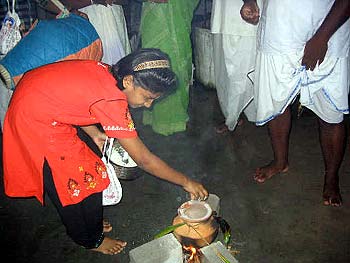|
Makara
Sankranti (Ponggal)
Commentary by Rama Ratan Prabhu, Malaysia,
about this traditional festival
This holy festival is celebrated for three consecutive days. Interestingly,
this is the only festival in the Hindu calendar that follows a
solar calendar and is celebrated on the fourteenth of January
every year (all other Hindu festivals are computed using the lunar
calendar).
This holy day marks the commencement of the Sun's northern course
in the Heavens, known as the uttaraayana patha. This turn in the
Sun's course takes place at the point of time when it enters the
sign of Makara or Capricorn. Sankranti is termed as 'Ponggal'
in Tamilnadu, and is celebrated with a popular dish with the same
name. Kolams (rangoli), sugar cane, mango leaves and turmeric
leaves are used as decorations to celebrate the festival.
The first day it is celebrated for the harvested crops and share
with friends and relatives. A new pot, bricks, firewood, milk
and rice are required for this festival. The second day cows are
worshipped and given the offerings. The cows are given a bath,
their horns painted and they are decorated with new cloths. And
on the third day the young unmarried ladies wearing new clothes
and gold and silver ornaments will have special prayers for their
future marriage.
In different parts of India, the Sankranti is celebrated very
differently. In the Western parts, the emphasis is on exchanging
'til-gul' which is a specialty of Konkani/Marathi women. It is
a preparation of sugar coated seeds and nuts of different colors
prepared by the housewives. In some other parts, exchange a mixture
of teel, jaggery, fried gram, groundnuts (peanuts) which is called
'ellu bella.' Along with sweets, flowers, bangles, dry fruits,
sugarcane and sugar candies are also exchanged. In the old Mysore
region, people decorate their houses and cattle. They also worship
their crop and cattle. As part of the celebration they sing and
dance, and look forward for flowering of the trees and singing
of birds.
In Hindu belief, a person dying on this auspicious day directly
goes to the heaven. Bhishma, an elder in the Mahabharata, is said
to have waited for this day to breathe his last. It is also on
this day every twelve years the Great Kumbha-Mela is held at Prayag.
|
![]()
![]()
![]()
![]()








